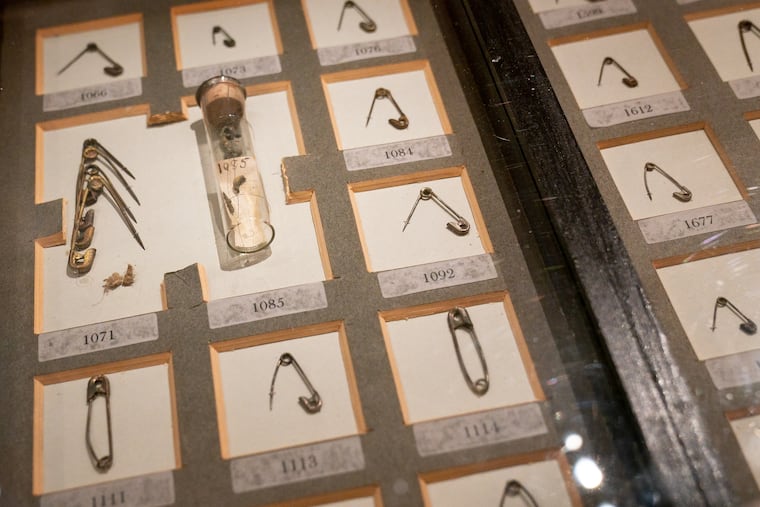Come for the colon, stay for the skulls: Touring the Mutter Museum’s overlooked oddities
A jar of skin flakes, a wall of eyes. Horrors everywhere.

This is the first part of a new series looking at overlooked items in local museum collections. If you’d like to suggest a museum to visit, write to jladd@philly.com.
The Mutter Museum’s collection of morbid curiosities is world-renowned, but prospective audiences often gravitate to the all-star attractions: the mega colon, Einstein’s brain, the plaster cast of the conjoined twins, the Soap Lady (who doesn’t look all that clean, to be honest). The place is a maze of display cases; surely there are some less infamous items just waiting for a chance to creep into the limelight.
Asked to point out some of her favorite under-the-radar items, curator Anna Dhody laughs. “I’d have an easier time naming my favorite child,” she says. She waits a beat before revealing that she only has one kid.
Dhody leads a quick safari through the museum, detailing the quirky, sometimes gruesome backstories of this jar, that skull, those tumors. The 70-pound cyst that looks like a baked russet potato inflated to the size of a corgi. The patch of skin with the clown tattoo. Horrors everywhere. Fueled by Dhody’s knowledge and enthusiasm, here are five unattractive attractions you should take a look at, for as long as you can bear to.
Syphilis Skull
The Mutter has a lot of skulls but this one, quarantined from the rest, is particularly striking. It’s mostly the giant hole in the forehead and brow that grabs your attention. The skull’s owner lived in the mid-19th century and died in excruciating pain from the syphilis eating away at him inside and out, with sores and viral infections (like the one that chewed through his cranium).
Syphilis remains a common STD today but is often caught early and treated with antibiotics. Back then they treated it with mercury pills and ointments, which could also kill you.
Dhody recalls an old Victorian warning: “One night with Venus, a lifetime with Mercury.” Then, because the whole discussion wasn’t strange enough, she mentions the uptick in syphilis cases in nursing homes.
Drawer of Swallowed Pins
Dr. Chevalier Jackson didn’t call ’em safety pins, he preferred “danger pins.” In the late 19th and early 20th century, the Philadelphia laryngologist made it his specialty to extract them from people’s throats, and he pioneered methods for getting in there, turning pins around, and closing them so they could be removed without cutting the patient open.
It’s not just danger pins, though. There are also buttons and jewelry and coins and so on. All told, the Mutter has some 2,374 “inhaled or swallowed foreign bodies” in the drawers beneath the staircase to the lower level.
Why were so many Philadelphians swallowing weird things back then? Were they all seamstresses and tailors who yawned too close to their workstations? No idea. Somewhat disturbingly, many of the pins in these cases look as shiny and clean and delicious as the day they were swallowed.
Eye Wall
Dhody says everybody subconsciously scratches their eyes while gazing upon the Mutter’s 100 or so wax models depicting various ailments and disfigurements of the eye. Two minutes later she catches me scratching. It’s hard not to have a visceral reaction.
Created in Paris in the late 1800s for instructional purposes, each of these life-size tiles signifies a person on, one hopes, the worst day of their life. The eyes are swollen, pockmarked, withered, empty-socketed. Each affliction is so awful to contemplate that you quickly move on to the next item. Well, good luck. That one’s gross, too. They’re all gross.
Jar of Skin Flakes
Most of the Mutter’s collection focuses on physical ailments, but some items — like this midsize mason jar full of skin flakes — are included to evoke the more tangible effects of mental illness.
The bits, which resemble Trader Joe’s coconut chips, were sent to Dhody by a woman who suffers from dermatillomania, an impulse-control disorder that results in skin picking. In this woman’s case, the flakes are peeled from the soles of her feet. This is the second batch she’s sent, and there’s a third installment in Dhody’s office waiting to be jarred.
Wax Model Arm with Smallpox
Philadelphia has had a hand in the surprisingly long history of the anti-vaccination movement. For one thing, Ben Franklin used to pen anti-inoculation articles under the name Silence Dogood, though he changed his mind after his son Franky Franklin died of smallpox at age 4. For another, our fair city hosted the National Anti-Vaccination Conference in 1908, helping to fuel a campaign that now includes actress Jenny McCarthy and singer Billy Corgan (neither of whom are scientists).
This wax arm — housed in a glass cylinder in one of the Mutter’s many corners — was used to illustrate the symptoms of the deadly, rash-inducing virus to medical students in the 1800s. Its skin is landscaped with hideous pink and white bumps. Smallpox ran rampant for 3,000 years until a massive vaccination effort finally wiped it out in the 1970s. Now it only exists in top-secret Russian and U.S. labs.
Safer and more easily preserved than an actual diseased limb, this model still has a few lessons up its metaphoric sleeve for the anti-vaxxer crowd. Please, people. Think of Franky Franklin.